The Checker Maven
The World's Most Widely Read Checkers and Draughts Publication
Bob Newell, Editor-in-Chief
Published every Saturday morning in Honolulu, Hawai`i
Noticing missing images? An explanation is here.
Demolition

As we delve further into Willie Ryan's famed Tricks Traps & Shots of the Checkerboard, we come across still more interesting and useful positions. This month we look into A Scotsman's Scoop and Denvir's Demolition. Listen up as Willie himself explains.
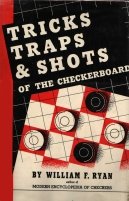
A Scotsman's Scoop
I am unable to find the appended trim snare recorded by any previous connoisseur of the stroke art. It was shown to me by Paul R. Semple, of Martins Ferry, Ohio, who reports he got it from an old Scotsman. Old or new, it's a practical example and belongs in every checker enthusiast's notebook. Move:
11-15 23-18 9-14 18-11 8-15 22-17 4-8 26-23 7-11 23-19 5-9 30-26 9-13---A. See the diagram.
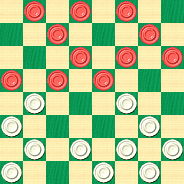
WHITE
White to Play and Win
W:W17,19,21,24,25,26,27,28,29,31,32:B1,2,3,6,8,10,11,12,13,14,15.
A---This is where black bites the dust. The following moves will bring about a draw: 15-18, 19-15, 10-19, 17-10, 6-15, 27-23, 18-27, 32-7, 3-10, 26-23, 8-11, 25-22, 9-14, 29-25, 2-6, 22-17, 15-18, 24-19, 18-27, 31-24, 11-15, 24-20, 15-24, 28-19, 14-18, 17-14, etc. Wm. F. Ryan.
Denvir's Demolition
9-14 22-18 5-9 25-22 11-16 24-19 8-11 27-24---A 16-20 31-27 11-16 29-25 4-8 19-15 10-19 24-15 7-11 22-17
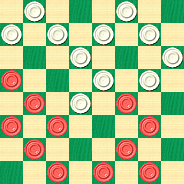
BLACK
Black to Play and Win
B:W32,30,28,27,26,25,23,21,18,17,15:B20,16,14,12,11,9,8,6,3,2,1.
The stage is all set for a startling stroke, leaving white hopelessly beaten. This clever whirligig is generally credited to the late John T. Denvir of Chicago, but it was probably known and shown by other champions before he was born.
A---A losing move often made by beginners, after which there is no scientific salvation. Either 22-17, 30-25, or 28-24 will draw.
After trying the problems, you don't need to be a Scotsman to demolish all difficulties by clicking on Read More for the solutions.![]()
Bowen and Lyman's Double Play
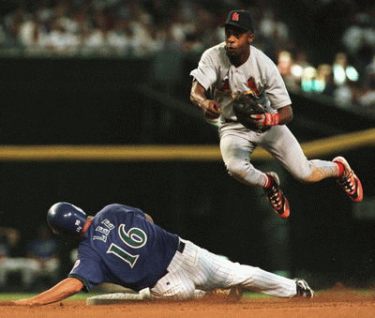
We hope you managed to turn last month's Triple Play but if not, here's a chance to make a double play instead, as our lessons in Checker School continue with a pair of related positions.
In the first problem, White is a man up but Black is going to quickly even the count. How is White to pull off a win?
In the second problem, forces are even, but the White king is pursuing the lonely-looking Black men. Can you show how Black can save the draw?
BLACK
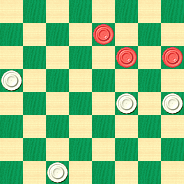
WHITE
White to Play and Win
W:W13,19,20,30:B7,11,12.
WHITE

BLACK
Black to Play and Draw
B:W30,20,K7:B19,18,10.
Whether it's short to second to first or some other way, turn the double play before clicking on Read More to see if your solution is "safe."![]()
White to Move and Draw, Again

Last time we presented a less usual "move and draw" stroke problem, and we liked the concept so much, we're presenting yet another of the same ilk. At least subjectively, though, we think this one is a bit easier, but you'll have to draw your own conclusion.
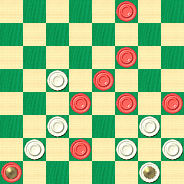
WHITE
White to Move and Draw
W:W14,22,24,25,27,28,K32:B3,11,15,18,19,20,26,K29.
Sketch your solution, and don't erase it until you've clicked on Read More to see if everything is in line.![]()
Fourth Of July Race

Fourth of July, coming up in a few days from the date of publication of this article, is of course the Independence Day holiday here in the US. It's invariably celebrated with fireworks, picnics, and games.... including many a Fourth of July race.
Can you win the race against our relentless clock and solve our July speed problem? Click below to show the problem and start the clock. Our problem is a bit on the easier side, so that you'll have more time to spend at the picnic.
July Speed Problem (easy)
When you have your solution, don't lose time; click on Read More to check your answer.![]()
Trouble In The Old Fourteenth

From time to time, we like to recall a classic position, one that in a way is like excellent brandy. If you've experienced it before, you will anticipate the fine flavor and be glad to enjoy it again; and if you haven't previously had the pleasure, you're in for a sophisticated and memorable treat.
Today, we're bringing back a trap in the popular go-as-you-please Old Fourteenth opening, said opening so-named simply because it was the fourteenth item in early editions in the ancient and venerable checker books of Payne and Sturges. Here's a run-up to the position of interest:
11-15 23-19 8-11 22-17 4-8 17-13 15-18 24-20 11-15 28-24 8-11 26-23---A 9-14---B 31-26 18-22?
A---25-22 might be considered the main line but this move is perfectly sound.
B---3-8 also draws.
The situation now looks this way:
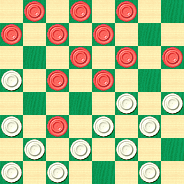
WHITE
White to Play and Win
B:W20,14,13,12,10,9,8,7,6,4,3,1:B32,31,30,28,27,26,23,22,21,19,18,11.
Over the board, and without your computer or your opening books, can you find the line of play that wins for White? Can you correct Black's losing move? We're guessing that the more experienced readers will find their way here, but for the rest of us, it could be a bit of a challenge.
No matter where you stand, you can uncap the solution and drink deeply of traditional checker knowledge by clicking on Read More.![]()
Hefter's Triple Play

This month's lesson in Checker School is due to Mr. Charles Hefter, famed analyst, problemist, and player, who held forth in the last part of the 19th century. We present three positions, closely related but with slight changes from one to the next. Yet, as we well know, subtle differences matter a great deal in our game. These studies were originally published decades ago in Ben Boland's Famous Positions in the Game of Checkers, but remain fresh and interesting today.
BLACK
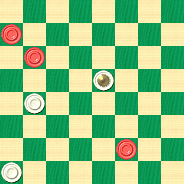
WHITE
White to Play and Win
W:WK15,17,29:B5,9,27.
BLACK
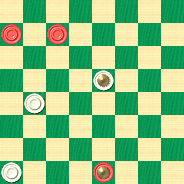
WHITE
White to Play and Win
W:WK15,17,29:B5,6,K31.
WHITE

BLACK
Black to Play and Draw
B:W21,K18,17:BK27,9,5.
Try out these problems and see if you can retire the opposition by turning a triple play. Then, clicking on Read More will bring you Ben Boland's complete analysis, notes, play, and variations, all without missing a single pitch.![]()
Bumped Off

It's time for another installment from Willie Ryan's classic Tricks Traps & Shots of the Checkerboard. This month we'll see a practical example of the "run-off" tactic, and one of the earliest "gotchas" ever published. But we're sure you'd rather hear from Willie directly.

Bumped Off on the Run-Off
As a general rule, it is sound strategy to attack an advanced piece by squeezing or running it off. In the following example we have a good illustration of what can happen when a player tries to maintain an advanced piece against tactical pressure.
11-16 24-20 16-19 23-16 12-19 22-18 8-11 27-23 4-8 23-16 8-12 32-27 12-19 27-23 3-8---A.
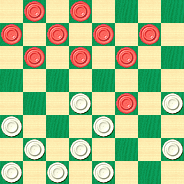
WHITE
White to Play and Win
W:W18,20,21,23,25,26,28,29,30,31:B1,2,5,6,7,8,9,10,11,19.
A---Black gets a rude awakening after this plausible push. The right route to draw is: 11-16, 20-11, 7-16, 18-15, 9-14, 15-11 (25-22, 6-9 draws), 6-9, 25-22, 9-13, 22-18, 10-15, 18-9, 5-14, 29-25, 15-18, 26-22, 18-27, 31-15, 2-6, etc.
The Scrub's Delight
11-15 23-19 8-11 22-17 4-8---A 17-13 15-18 24-20 11-15 28-24 8-11 26-23 9-14 31-26 6-9 13-6 2-9 26-22 9-13---B.
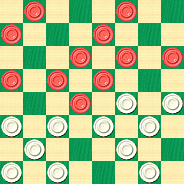
WHITE
White to Play and Win
W:W19,20,21,22,23,24,25,27,29,30,32:B1,3,5,7,10,11,12,13,14,15,18.
The illustrated layout was one of the earliest standard pitfalls to be recorded in checker literature, being first shown, in 1800, by that pioneer chronicler of the checker art, Joshua Sturges. Appropriately labeled "The Scrub's Delight," it has probably dropped more novices than any other trap on the board.
A---Completes the Old Fourteenth opening, one of the first and most popular developments tackled by the learner. Winning chances are about equal.
B---Time-tested standard play to here. The text loses, forming the Scrub's Delight. The correct play to force a draw is: 1-6, 22-17, 18-22, 25-18, 15-22, 23-18, 14-23, 27-18, 9-13, 17-14, 10-17, 21-14, 6-10, 30-25, 10-17, 25-21, 22-26, 21-14, 26-31, 19-15, 31-26, 15-8, 26-22, 32-28, 22-15, 24-19, etc.
Don't get bumped off and don't be a scrub. Try out the problems and then click on Read More to check your solutions.![]()
Faster Than A June Bug

Actually, we're really not sure how fast a June bug might be, but you'll need to be at least as fast to solve the June speed problem. Although not conceptually difficult, it does require good visualization. Click below to show the problem and start the clock. You have 60 seconds!
June Speed Problem (Easy to Medium)
Try the problem, and if you're stuck, don't be bugged! Fly your mouse over to Read More to reveal the solution.![]()
Introducing Priscilla K. Snelson (conclusion)

We last left our hero, Marvin J. Mavin, in somewhat dire straits. Recall that in Part One of the story (click here to read it again) Marvin and his girlfriend Priscilla were at a fancy champagne party. Marvin got into an argument with Russian Draughts master Dmitri Tovarischky and a challenge game, with a thousand dollars riding on the outcome, was in progress. We pick up the story with Marvin a man down in the game and not a beer in sight.
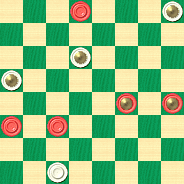
WHITE (Marvin)
White to Play
W:WK4,K10,K13,30:B2,K19,K20,21,22.
Marvin continued to fidget in his chair and mutter under his breath. Then, suddenly, he leaped to his feet, grinning widely, and played:
| ... | 13-17 |
"Why Checkers Boy is laughing?" asked Dmitri, obviously annoyed with Marvin's antics. "You think chasing my man is smart move. Watch, Dmitri is only getting another king!"
The game continued:
| 22-25 | 17-22 |
| 25-29 | 4-8 |
Suddenly Dmitri's expression changed from a satisfied scowl to a concerned and puzzled look. "Pieces on 29, 21, and 2 cannot move," he said quietly. "Why is situation so difficult now for great Russian champion?"
Marvin had settled in his chair, no longer moving about. A sly smile was all that could be seen on his face. The watching crowd, too, was silent. They were no longer even sipping their champagne. Play went on:
| 19-16 | 10-14 |
| 2-6 | ... |
Dmitri let out a long breath. "Ha, Checkers Boy! You see! Man is moving now and Russian Champion will win game!"
| ... | 14-18 |
But now Dmitri was scowling again. "Da, da, da, man goes to 9 and gets lost when King moves 22 to 17 and then to 13. Checkers Boy is thinking he is clever boy...."
| 20-24 | 18-14 |
| 24-19 | 22-17 |
| 19-24 | 17-22 |
| 24-27 | 14-17 |
| 6-10 | 22-18 |
Marvin lifted his head and spoke in a manner that was, at least for him, uncharacteristically quiet. "You ain't going nowhere, are ya, Pinko!"
| 29-25---A | ... |
"OK big Checkers Boy! Now king is moving from corner!" gloated Dimitri.
| ... | 17-13 |
"Nyet, nyet, nyet! Dmitri will not put king back in corner!"
| 27-24 ?---B | ... |
Marvin sat up straight and exclaimed, "Losing patience, are ya now! Well take this!"
| ... | 18-14! |
| 10x17 | 13x29 |
Drawn.
A---Accomplishes nothing, but neither does anything else. 27-24 might be a little better.
B---25-29 doesn't allow the quick wrapup, but still only draws, as Black can make no progress.

Marvin jumped up, raised his arms, leaped and clicked his heels in mid-air. "Did you see that! Did YOU see that! Yeah, ya fat Russkie, you were gonna beat old Marvin, were ya! Well I showed ya didn't I!"
Marvin's girlfriend Priscilla, who up to this point had kept a bit of a distance from the playing table, was starting to get a very unpleasant tight and white look. "Marvin...you only got a draw and you really ought to be a little nicer..." she began to say, in a voice that was a little too calm. But Marvin could not be stopped, as he turned his attention to the watching crowd.
"And all a youse!" he said, "Hangin' around waitin' for poor ole Marvin to lose so Russkie here can buy ya all some expensive vodka! Yer all a bunch a put-ons! Ya oughta drink beer like real people!"
"MARVIN, YOU CAN FIND YOUR OWN RIDE HOME!" shouted Priscilla in a most unladylike manner. She turned on her heels and strode to the exit, letting the door slam behind her.
"Uh.... honey?" said Marvin, taken with surprise. But it was too late.
The crowd dispersed quickly, the party mood of the evening ended. Dmitri was no longer anywhere to be seen, having silently slipped away at the end of the game. Somewhat sullenly, Marvin packed up his checkers and board, and went out alone into the night, hoping to find a bar still open where he could at least get a beer.![]()

If you are of legal age and choose to drink, The Checker Maven asks that you do so in a responsible manner. Drinking and driving is a serious and dangerous crime; please don't ever do it.
White to Move and Draw, Cowboy

Most stroke problems have as terms that one side or other is to move and win. In this month's problem, though, we're only looking for a draw, so obviously, the problem must be easier than most, wouldn't you say?
Perhaps by now you know us better than that! Today's problem will require your best efforts at visualization in order to earn the draw in the following situation.
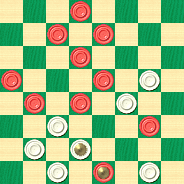
WHITE
White to Play and Draw
W:W16,19,22,25,K26,30,32:B2,6,7,10,13,15,17,18,24,K31.
Just don't be too quick on the draw yourself; give the problem a try before clicking on Read More for the solution.![]()
The Checker Maven is produced at editorial offices in Honolulu, Hawai`i, as a completely non-commercial public service from which no income is obtained or sought. Original material is Copyright © 2004-2026 Avi Gobbler Publishing. Other material is public domain, AI generated, as attributed, or licensed under CC1, CC2, CC3 or CC4. Information presented on this site is offered as-is, at no cost, and bears no express or implied warranty as to accuracy or usability. You agree that you use such information entirely at your own risk. No liabilities of any kind under any legal theory whatsoever are accepted. The Checker Maven is dedicated to the memory of Mr. Bob Newell, Sr.

